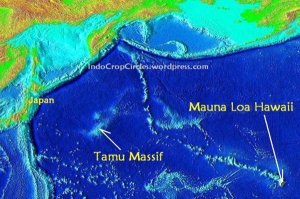Wikipedia defines “crosswordese” as “the group of words frequently found in crossword puzzles but seldom found in everyday conversation”. But here at Chris Words, knowledge is power, and everyone deserves a second chance. In these interviews, we learn more about the words that make up crosswordese, and what makes them so great.
Edition #2: KEA and LOA
(KEA has appeared 128 times in the NYT, 46 in the Shortz era)
(LOA has appeared 238 times in the NYT, 73 in the Shortz era)


In this second edition of “The X-word Files”, we travel to the 50th state and learn more about Mauna Kea and Mauna Loa, two prominent mountains/volcanoes on the Big Island of Hawaii. To learn more about these geographic wonders, we talked to Dr. Ken Rubin, a volcanologist who is currently a professor and chair of the Department of Geology and Geophysics at the University of Hawaii. You can check out his personal page here and check out his Twitter page here. We asked Dr. Ken Rubin nine questions about the two peaks, and here’s what he sent us:
KR: The names are more figurative than realistic. Both of the mountains are large and gently sloped, and both get snow at the summit in the winter. Mauna Loa is larger (it covers more than half of the big island) and has large rift zones, giving it an elongate shaped when viewed from some angles, such as at Kilauea summit. Mauna Kea is a bit more peaky due to secondary volcanism leading to small cinder cones near the summit in the last few 10,000 years.
2. Maybe the most obvious question to ask about volcanoes: How active are Mauna Kea and Mauna Loa?
 Mauna Kea is dormant. It has erupted in the past 10,000 years, but not historically. Hawaiian volcanoes go through a sort of life cycle of increasing volcanism, then stable output, then decreasing volcanism, all related to how the Pacific Plate moves over the hot spot that makes magma in the mantle, sometime followed by a later rejuvenation stage. Mauna Loa is in the stable output stage and Mauna Kea is in the waning stage. Kilauea, which sits on the SE side of Mauna Loa is often called the most active volcano on the planet. It has been erupting continuously since 1983, and there is evidence of other multi-decade to perhaps a century long eruption in the prehistoric geological record.
Mauna Kea is dormant. It has erupted in the past 10,000 years, but not historically. Hawaiian volcanoes go through a sort of life cycle of increasing volcanism, then stable output, then decreasing volcanism, all related to how the Pacific Plate moves over the hot spot that makes magma in the mantle, sometime followed by a later rejuvenation stage. Mauna Loa is in the stable output stage and Mauna Kea is in the waning stage. Kilauea, which sits on the SE side of Mauna Loa is often called the most active volcano on the planet. It has been erupting continuously since 1983, and there is evidence of other multi-decade to perhaps a century long eruption in the prehistoric geological record.3. At 18,000 cubic miles, Mauna Loa is often considered the largest volcano on Earth, while Tamu Massif in the northwest Pacific can also be considered for that title. That debate arises from recent evidence of Tamu Massif being a single volcano, rather than multiple volcanoes. What’s the consensus in the geologic community?
 KR: Mauna Loa is a clearly defined, young volcanic edifice that can be observed and mapped on its surface in high fidelity and in the interior reasonably well (by drilling and various geophysical methods), giving us a good idea of the structure. Tamu Massif is an old, submerged structure covered by marine sediment and for which the internal structure is largely inferred. The evidence that it formed as a single volcano from a point source of eruption is conjectural and difficult to prove or disprove, but if it were a single edifice (volcano), it would be structured like no other volcano we know on Earth, or the large volcanoes on Mars, like Mons Olympus. There is therefore no consensus on Tamu Massif, but I would say more volcanologists suspect it isn’t a single volcano than think that it is. It would need far more study before we can have the data to make the assertion that it is one volcano.
KR: Mauna Loa is a clearly defined, young volcanic edifice that can be observed and mapped on its surface in high fidelity and in the interior reasonably well (by drilling and various geophysical methods), giving us a good idea of the structure. Tamu Massif is an old, submerged structure covered by marine sediment and for which the internal structure is largely inferred. The evidence that it formed as a single volcano from a point source of eruption is conjectural and difficult to prove or disprove, but if it were a single edifice (volcano), it would be structured like no other volcano we know on Earth, or the large volcanoes on Mars, like Mons Olympus. There is therefore no consensus on Tamu Massif, but I would say more volcanologists suspect it isn’t a single volcano than think that it is. It would need far more study before we can have the data to make the assertion that it is one volcano.
4. How difficult is it to ascend Mauna Kea or Mauna Loa? Can the tops be reached on either volcano without specialized equipment or special access?

KR: One can drive to the summit of Mauna Kea, which is necessary for staff and service people to visit the sophisticated telescopes there. Snow boarders also go up there in the winter. Mauna Loa summit can be reached on foot from two trails (the SE, from within the National Park, and the N, from the famous Mauna Loa observatory, where atmospheric CO2 has been monitored since the late 50s). Both are relatively easy and gentle walks, but at over 13,000 ft elevation at the top, difficult for many hikers/backpackers. There is a small cabin at the Mauna Loa summit for staying overnight, sitting on the edge of the caldera.
 5. The Mauna Kea Observatories is a world-class location for astronomical investigations, highlighted with the Keck Telescopes. Why is Mauna Kea such an ideal location for the observatories?
5. The Mauna Kea Observatories is a world-class location for astronomical investigations, highlighted with the Keck Telescopes. Why is Mauna Kea such an ideal location for the observatories?
KR: Its position near the equator, its low light pollution from nearby population centers, and the high altitude/dry atmosphere all contribute.
6. What unique flora and fauna can be found on the slopes of Mauna Kea and Mauna Loa?
KR: Both have many different biome zones, including tropical hardwood forests in some lower elevation locales. The east sides are wetter than the west, and both reach alpine like conditions at their summits.
 7. For coffee to be classified as Kona coffee, it has to be grown in the Kona Districts, cultivated on the slopes of Mauna
7. For coffee to be classified as Kona coffee, it has to be grown in the Kona Districts, cultivated on the slopes of Mauna
Loa and Hualālai. What makes this region so fertile for the coffee crop, and have other crops been grown in the same area?
KR: In Hawaii Coffee does best at moderate elevation (above about 2000 ft up to maybe 4000 or so). The conditions that make the Kona district so good include a combination of volcanic soil, cloud forest type precipitation, moderate temperatures.
KR: The best prevention is awareness and an alert system. Although there have been some efforts at lava diversion here in the early to mid 20th century, it is not currently employed. The gentle slopes, fast and continuous lava effusion rates, and flow inflation styles make flow diversion both a risky business and one with uncertain impacts. Many people live within high hazard zones at Kilauea because land is cheap (by Hawaii standards), but they own this land being aware of the risks and usually with respect for the occasional inevitable effects of living on one of Earth’s most active volcanoes.
 9. For any visitors coming to see the volcanoes of Hawaii, what are some of the highlights that someone should see (parks, museums, etc.)?
9. For any visitors coming to see the volcanoes of Hawaii, what are some of the highlights that someone should see (parks, museums, etc.)?
KR: There is much to see and do, most of it outside activities, eco-tourism, and cultural tourism. Visit the web sites of the National Park Service and the Hawaii Visitors Bureau to learn more. [Links provided]
Chris Words would like to thank Dr. Ken Rubin for answering our questions. Be sure to give him a follow at his Twitter found [here]. We hope you’ve enjoyed our interview, and we hope you’ll appreciate seeing these pieces of crosswordese in a future puzzle.
Chris Words will be back next week with a new puzzle.


[…] everyone, and welcome back to Week 37! I hope all of you enjoyed last week’s interview about Mauna Kea and Mauna Loa, and I would like to once again like to thank Dr. Ken Rubin for the […]
LikeLike
[…] Synergy: Last July, I interviewed the chair of the Department of Geology and Geophysics at the University of Hawaii about Mauna Kea and Mauna Loa as part of my crossword series “The X-word Files”, where I investigate words that appear frequently in puzzles, like KEA and LOA. Part of my interview talked about Kona coffee, which is grown in Hawaii. You can check out my interview with Dr. Ken Rubin [here]. […]
LikeLike